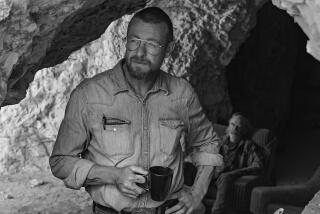With ‘Wind River,’ Oscar nominee Taylor Sheridan captures a chill of the soul
For the last two years, movie audiences have been treated to scripts by former actor Taylor Sheridan. These are character-rich pieces that quietly subvert their genres’ predecessors (David Mackenzie’s Oscar-nominated western “Hell or High Water”) or upend them entirely (Denis Villeneuve’s drug-trade thriller “Sicario”).
Turns out, Sheridan has been saving his boldest work for himself.
“I always knew I wanted to direct this screenplay,” Sheridan, 46, said by phone recently from his home in Wyoming. “So, I just didn’t show it to anybody. I hid it in a drawer for three years and just waited.”
The film in question is “Wind River,” a snow-bound thriller that will evoke “A Simple Plan” and a host of Coen Bros. works while retaining a style that’s distinctly Sheridan-esque. The waiting? Well, that was done so he could build enough of a track record for financiers to feel comfortable with him directing too.
SEE OUR COMPLETE SUMMER MOVIE PREVIEW »
The years paid off. The third in the writer’s so-called frontier trilogy, “Wind River” examines big themes like Native American-white tensions, geography-as-destiny and the residual nature of grief, all in the context of a potboiler. (The Weinstein Co. film opens in August.)
Sheridan’s directorial debut concerns a government animal trapper named Cory Lambert (Jeremy Renner), who lives in the rugged and wintry mountains of Wyoming. He was once happily married to a Native American woman and had two kids but now nurses a private pain due to a family tragedy — a tragedy that impels him to investigate the death of a young Native American woman on nearby reservation land.
Far from a simple procedural, however, “Wind River” ups the cultural stakes when a Florida-born FBI agent (Elizabeth Olsen) flies in to help solve the case, bringing the investigation into conflict with the closed Native American community. As with Sheridan’s previous work, the setting plays a key role; after the dusty-plained Texas of his earlier work, “Wind River” centers on an unforgiving-but-resplendent snow, shot so strikingly that just looking it can practically give you frostbite.
The character details are equally clarified. Whether it’s Lambert’s tortured soul or the wary Native Americans, the people of “Wind River” are textured and lived-in, with quirks and flaws.

I like writing love poems to these places. But as someone who tries to be a naturalistic storyteller, my love poems do point out the warts.”
— Taylor Sheridan
“I like writing love poems to these places,” Sheridan said. “But as someone who tries to be a naturalistic storyteller, my love poems do point out the warts.”
The filmmaker spent much of his adolescence in Wyoming after his parents divorced; the movie is informed by his time there. In fact, Sheridan (TV fans will recall him as David Hale from “Sons of Anarchy”) moved back to the region four years ago, leaving Los Angeles with his wife around the time his child was born. He now splits his time between Wyoming and the Park City, Utah, area, living a life of writerly isolation. (“I don’t even know what a siren is anymore. If I hear a one, I can call and ask, ‘Uh oh, what happened to Bob?’”)
He also spent part of his 20s on a reservation, finding the simplicity as appealing as he did the social challenges distressing. He believes reservations to be a natural spot for a story about an unsolved assault, in part because of the skepticism with which Native American leaders regard white America, in part because they’re in places with little media or means of communication.
That remoteness was no production deterrent, however. Sheridan and his cinematographer, Ben Richardson, undertook some serious challenges shooting in Wyoming and northern Utah — not least of which was getting camera rigs in places only snowmobiles tread. (He used a lot of handhelds.)
They also had to contend with erratic snow patterns. The film needed snow, and it’s too expensive on an indie budget to manufacture or CG any of it in. That could seriously throw off his filming, so Sheridan designed an entire alternate shoot schedule that would allow him to shift his plan with the weather.
Sheridan, who cites Clint Eastwood and Michael Mann as influences for what he calls “naturalistic genre films,” says he thinks the modern way has actually been paved by another medium.
“Television is responsible for allowing these kinds of movies — whether you take ‘Breaking Bad’ or ‘The Sopranos” or any of the others, they were all trying to say something about the genre they live in.”
Sheridan added, however, that the wide-screen format was critical for his style — and, equally important, for the empathy he wanted to create.
“I think film cannot only teleport you to places you don’t know, but it can help you see people you thought were one way and in fact are another,” he said. “They can allow us to examine ourselves.”
See the most read stories this hour »
More to Read
Only good movies
Get the Indie Focus newsletter, Mark Olsen's weekly guide to the world of cinema.
You may occasionally receive promotional content from the Los Angeles Times.







